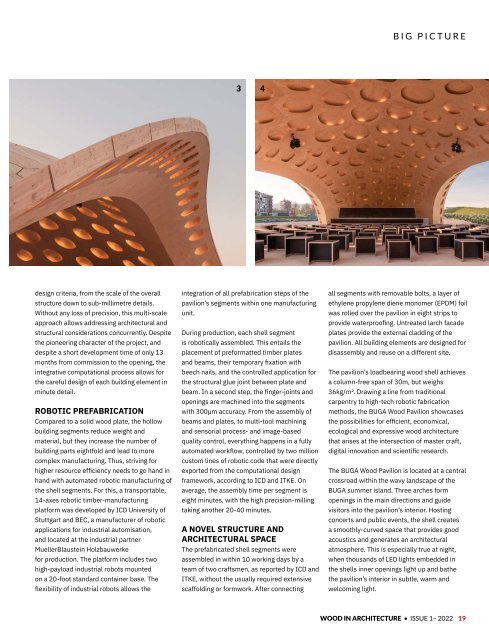Wood In Architecture Issue 1, 2022
First published in 2017, Wood in Architecture (WIA) is a bi-annual trade magazine devoted to the international timber construction sector. The newest addition to the Panels & Furniture Group of wood magazines, WIA features in-depth insights to the latest industry news, incredible projects and leading trade events. WIA is an advocate for timber as a material of choice for today’s built environment, and is the perfect source of inspiration for architects, builders, engineers and interior designers across the globe.
First published in 2017, Wood in Architecture (WIA) is a bi-annual trade magazine devoted to the international timber construction sector. The newest addition to the Panels & Furniture Group of wood magazines, WIA features in-depth insights to the latest industry news, incredible projects and leading trade events. WIA is an advocate for timber as a material of choice for today’s built environment, and is the perfect source of inspiration for architects, builders, engineers and interior designers across the globe.
You also want an ePaper? Increase the reach of your titles
YUMPU automatically turns print PDFs into web optimized ePapers that Google loves.
BIG PICTURE<br />
3 4<br />
design criteria, from the scale of the overall<br />
structure down to sub-millimetre details.<br />
Without any loss of precision, this multi-scale<br />
approach allows addressing architectural and<br />
structural considerations concurrently. Despite<br />
the pioneering character of the project, and<br />
despite a short development time of only 13<br />
months from commission to the opening, the<br />
integrative computational process allows for<br />
the careful design of each building element in<br />
minute detail.<br />
ROBOTIC PREFABRICATION<br />
Compared to a solid wood plate, the hollow<br />
building segments reduce weight and<br />
material, but they increase the number of<br />
building parts eightfold and lead to more<br />
complex manufacturing. Thus, striving for<br />
higher resource efficiency needs to go hand in<br />
hand with automated robotic manufacturing of<br />
the shell segments. For this, a transportable,<br />
14-axes robotic timber-manufacturing<br />
platform was developed by ICD University of<br />
Stuttgart and BEC, a manufacturer of robotic<br />
applications for industrial automisation,<br />
and located at the industrial partner<br />
MuellerBlaustein Holzbauwerke<br />
for production. The platform includes two<br />
high-payload industrial robots mounted<br />
on a 20-foot standard container base. The<br />
flexibility of industrial robots allows the<br />
integration of all prefabrication steps of the<br />
pavilion’s segments within one manufacturing<br />
unit.<br />
During production, each shell segment<br />
is robotically assembled. This entails the<br />
placement of preformatted timber plates<br />
and beams, their temporary fixation with<br />
beech nails, and the controlled application for<br />
the structural glue joint between plate and<br />
beam. <strong>In</strong> a second step, the finger-joints and<br />
openings are machined into the segments<br />
with 300μm accuracy. From the assembly of<br />
beams and plates, to multi-tool machining<br />
and sensorial process- and image-based<br />
quality control, everything happens in a fully<br />
automated workflow, controlled by two million<br />
custom lines of robotic code that were directly<br />
exported from the computational design<br />
framework, according to ICD and ITKE. On<br />
average, the assembly time per segment is<br />
eight minutes, with the high precision-milling<br />
taking another 20-40 minutes.<br />
A NOVEL STRUCTURE AND<br />
ARCHITECTURAL SPACE<br />
The prefabricated shell segments were<br />
assembled in within 10 working days by a<br />
team of two craftsmen, as reported by ICD and<br />
ITKE, without the usually required extensive<br />
scaffolding or formwork. After connecting<br />
all segments with removable bolts, a layer of<br />
ethylene propylene diene monomer (EPDM) foil<br />
was rolled over the pavilion in eight strips to<br />
provide waterproofing. Untreated larch facade<br />
plates provide the external cladding of the<br />
pavilion. All building elements are designed for<br />
disassembly and reuse on a different site.<br />
The pavilion’s loadbearing wood shell achieves<br />
a column-free span of 30m, but weighs<br />
36kg/m². Drawing a line from traditional<br />
carpentry to high-tech robotic fabrication<br />
methods, the BUGA <strong>Wood</strong> Pavilion showcases<br />
the possibilities for efficient, economical,<br />
ecological and expressive wood architecture<br />
that arises at the intersection of master craft,<br />
digital innovation and scientific research.<br />
The BUGA <strong>Wood</strong> Pavilion is located at a central<br />
crossroad within the wavy landscape of the<br />
BUGA summer island. Three arches form<br />
openings in the main directions and guide<br />
visitors into the pavilion’s interior. Hosting<br />
concerts and public events, the shell creates<br />
a smoothly-curved space that provides good<br />
acoustics and generates an architectural<br />
atmosphere. This is especially true at night,<br />
when thousands of LED lights embedded in<br />
the shells inner openings light up and bathe<br />
the pavilion’s interior in subtle, warm and<br />
welcoming light.<br />
WOOD IN ARCHITECTURE • ISSUE 1– <strong>2022</strong> 19


















